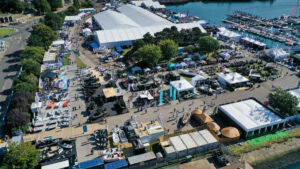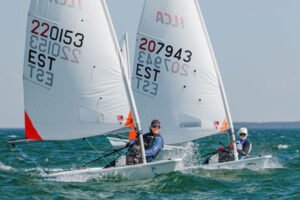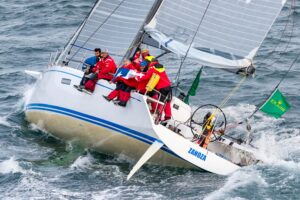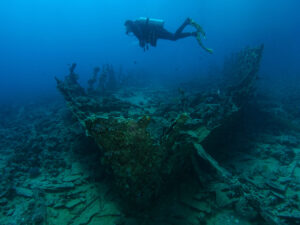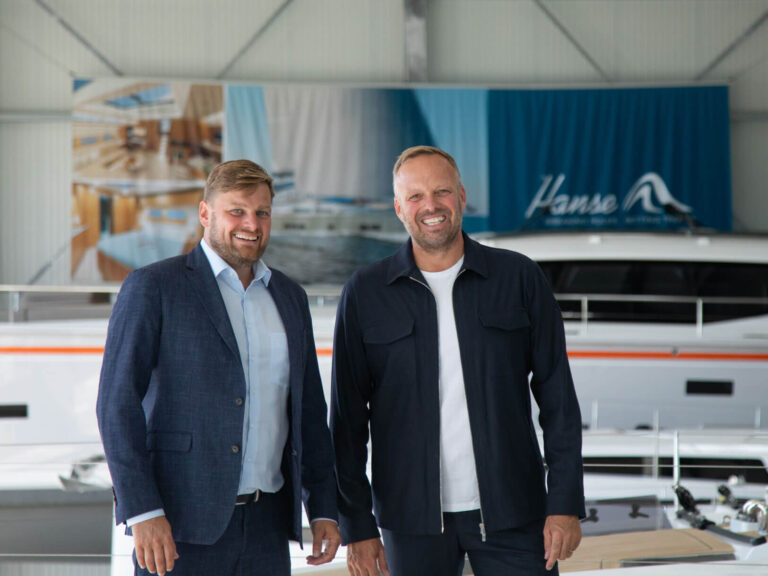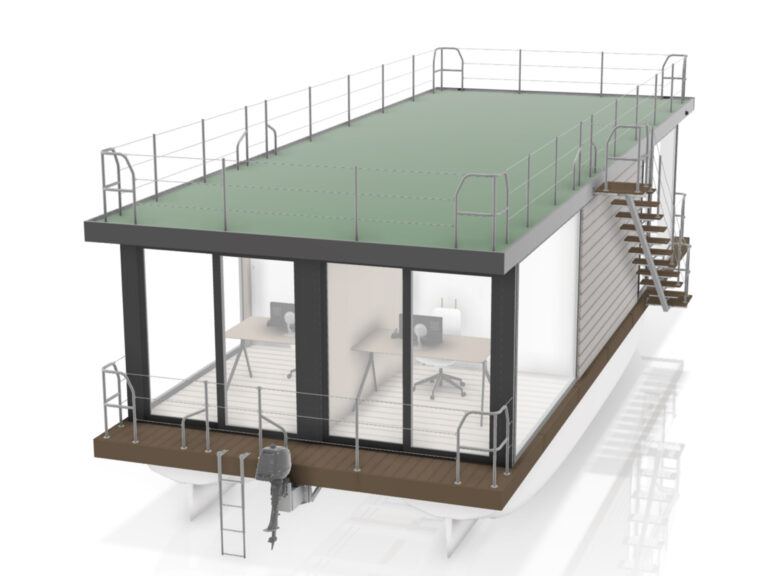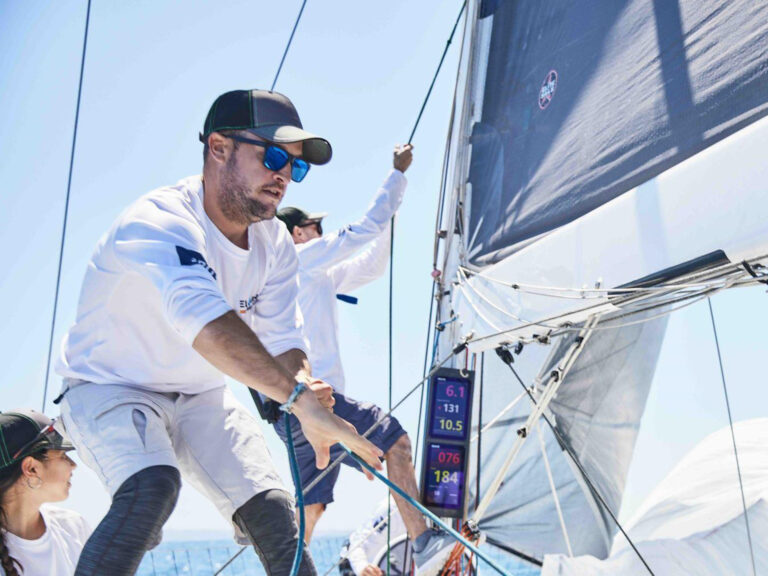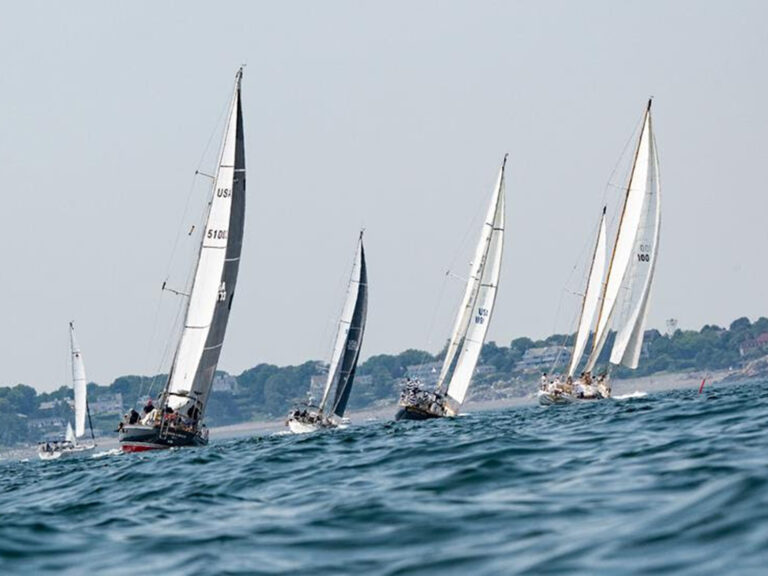
onboard Jackrabbit
Sailors considering a cruise along the coast of Maine should keep in mind that the hundreds of islands there fall into two distinct categories: ones with bridges leading to them and ones without. Both have their merits. It’s hard to go wrong in August with a Maine sailing trip. But given a choice, I’ll take the ones less traveled by, if for no other reason than that the locals there wave to you, on every island, almost every time.
On a brief summer’s cruise, we visited six Maine harbors, three that connected to the mainland by roads and three that didn’t. The ones with car-friendly hookups to America had everything Maine is famous for: fresh lobsters, pretty coves, soft summer nights, clear water. The remoter ones had all that and more.
Like beautiful Burnt Coat Harbor, at Swans Island, only a few miles from the roar and bustle of Bar Harbor, Southwest Harbor, and Northeast Harbor, on Mount Desert Island. OK, that’s an overstatement. Mount Desert is accessible to noxious cars, but it’s also the natal grounds for those elegant Hinckley and Morris yachts that you see bobbing around in pools of glitter and gloss the world around, and it’s home to pristine Acadia National Park. It’s not exactly, you know, Provincetown.
But Mount Desert, well, it’s not soothing Burnt Coat, either, where, when the fog lifts, you creep past softly chiming entrance buoys to find a cluster of pin-neat houses framing the harbor and half a dozen wooden schooners from the vintage-charter trade tugging at anchors, oil lamps dangling in the rigging and a young woman of arresting beauty perched on a bowsprit—and nattering on a cell phone, of course.
Four of us spent five days poking around coastal Maine from Mount Desert to Casco Bay. It wasn’t adequate time to even scratch the surface of the rich cruising life there, but it whetted the appetite, particularly for the placid islands that cars can’t get to on their own and where people acknowledge even complete strangers.
We were on a leisurely delivery from Halifax to Annapolis, bringing Tom Vesey’s Freedom 44, Jackrabbit, down from his six-week family cruise in Nova Scotia and Newfoundland to wait out the hurricane season in the Chesapeake before heading back across the Gulf Stream to Vesey’s home in Hamilton, Bermuda. When you arrive in the States from Canada, you must clear customs, of course, which meant stopping first at an auto-accessible port where immigration could “process” us. We picked busy Southwest Harbor, whose lights hove into view after we’d spent two cold days and nights at sea while mostly motorsailing against prevailing southwesterlies, often through fog.
We were under a rare patch of clear sky when we fetched the entrance, but it was still black dark at 0400. Vesey, ever cautious, elected to heave to and wait for daylight to plumb the unfamiliar channel, a strategy that backfired when clear sky degenerated into thick fog. Ah, the best-laid plans.
Westward we plunged anyway, into the spreading dawn, a cloud of mist, and a forest of lobster pot buoys so thick that it rendered the first-timers-to-Maine nearly speechless. “How does anybody ever get in and out of here?” muttered Hank Weed, my Annapolis, Maryland, neighbor, who’s had plenty of experience with crab pots in the Chesapeake but had never encountered anything like the buoy farms here.
As it will, the fog dissipated just as we cleared the entrance and by 0930 we were safely lashed to a floating dock at Dysart’s Great Harbor Marina, which has everything the weary cruiser could need, from Grumpy’s breakfast bar to a laundromat to an evening cabaret for entertainment. It was, Vesey noted, a far cry from Newfoundland.
The place was buzzing. By 1100, customs had been and gone, we’d all had showers, and we were already on the guest list for a big dinner party. It seems all you have to do to crack the social circle around here is wave the flag—in this case, the Cruising Club of America ensign. Vesey, a newly minted member, handed it up to the cockpit to run aloft, but before we could even get it on a halyard, we were set upon by club members from boats berthed nearby, who evidently monitor the docks for signs of the C.C.A. “Tonight’s our big summer party,” gushed Milton Baker, off the Nordhavn trawler next door. “You have to come.”
Foggy dusk found us slurping rum punch from a bottomless keg and picking at mountains of barbecued pork tenderloin and a groaning board of side dishes and desserts at the seaside home of Dick and Rocky Homer. It was a leap from tide-swept Cape Sable and the frigid Labrador Current we’d weathered a night or two before, but we were buoyed by snippets of respectful conversation overheard about “four guys on a ketch who just piled in from Halifax.”
Everyone brought a little something. We brought Gosling’s Black Seal, tar-colored Bermuda rum that Vesey stockpiles in the bilge for “gifts to natives.” A glorious night it was, capped off by the ride back to the marina in octogenarian Jim Gourd’s new Lincoln S.U.V. with a GPS even more sophisticated than Jackrabbit’s, which is saying something. Gourd had a bit of parting advice: “Don’t even bother going over to Bar Harbor,” he said. “It’s a freakin’ zoo!”
So next morning, we dutifully set off in the opposite direction, bucking a fresh breeze toward Swans Island and Burnt Coat Harbor 10 miles away, motorsailing briefly alongside the most beautiful yacht in the world, the 138-foot, low-slung, flag-blue, Frers-designed ketch Rebecca, which charged up our transom at a scalding rate and was about to leave us in her wake when a fresh fog bank swept in. At that, Rebecca turned tail like a big, scared bunny, leaving us to navigate the twists and turns of the narrow channel through the Cranberry Isles alone.
Well, not exactly alone. You really get a handle on how Maine people earned the nickname “Mainiacs” when you pick your way through a fog on a weekend in a busy channel. Vesey was beside himself with worry, tooting the foghorn and monitoring the radar to avoid potential collisions. Meantime, every boat we saw seemed peopled exclusively by tipsy, carefree revelers who whistled and hooted at us as they reared up and roared by in the cloying mist.
It was a relief to check off the last green daymarker at the hairpin entrance to Burnt Coat and watch the haze lift again. The harbor was awash in pretty boats, reminding me of my old Annapolis friend Andy Hughes’s observation a few years ago when he first visited Maine. “The difference between here and home,” he’d said, “is there’s no junk up here.”
By that he meant no hordes of the top-heavy, fiberglass, 28-foot stinkpots that buzz around the Chesapeake all summer towing towering wakes, their skippers and crews invisible behind air-conditioned, canvas-enclosed flying bridges. New Englanders have better taste, and nowhere is that more evident than in the mooring fields at Burnt Coat and similar outlying Maine ports, where wooden lobster boats bob alongside tasteful cruising sloops and weathered wooden schooners from the windjammer fleet. (By the way, a dozen windjammers still cruise in Maine waters, summer and fall, offering week-long trips to punters for under $1,000 per person, including meals. Nice deal, no?)
We were just settling down to a round of frosty sundowners when the dulcet tones of sea chanteys wafted across the water. Moments later, a tidy yacht called Penrose of Essex was alongside, with two dozen full-throated lads and lasses belting out verses from “Barrett’s Privateers” and demanding we sing along on the chorus, which we did. This traveling choir tours Maine islands and was drumming up trade for that night’s concert at the Odd Fellows Hall. One small problem: The concert was already sold out. “But come by the back entrance and we’ll sneak you in,” the lead singer said with a conspiratorial wink.
Tempting, but instead we re-established our land legs with a long walk up the tree-lined main drag, where each of the drivers in a ragtag assortment of passing cars and trucks offered a wave and a smile, as is the ageless custom in Maine once you leave the mainland astern. Some island kids had lukewarm lemonade waiting at the top of the hill for 25 cents a glass, proceeds to benefit the local lighthouse restoration. We sat on a sun-washed stonewall and sipped their sweet elixir, scanning a harbor that sparkled like spun gold in the waning sunlight. It was ghostly quiet, quiet as a church—a million miles from that freakin’ zoo at Bar Harbor.
I’d assured the lads that fog was fairly unusual in Maine in August. Days are mostly cool and bright, by my recollection, but I was beginning to doubt my own memory. Happily, that morning was the last we saw of serious fog as a light nor’wester blew in and swept the skies clean for the rest of the week. Seizing on the weather shift, we were off early next morning before even taking time to pick a destination. Isle au Haut? Vinalhaven? Metinicus? Monhegan?
All those picturesque harbors slid by unexplored as we motorsailed southwest under all plain sail. Vesey, mindful of his many miles to go, was disinclined to put in before late afternoon, so we skipped past one potential pretty stop after another, tracing our track using the indispensable Cruising Guide to the Maine Coast (5th edition, 2008), a coffee-table sized hardcover written by Hank and Jan Taft and Curtis Rindlaub.
“Boothbay Harbor?” Weed suggested, glancing up from the guidebook. That sounded reasonable, though busy. We struck a course for there, ruing the fact that we’d be entirely bypassing Penobscot Bay, considered by many to be Maine’s finest cruising grounds. At Pemaquid Point we modified the plan, opting to stop just short of Boothbay at Christmas Cove, on Rutherford Island, which sounded quieter and quainter.
And so it was. The small, crowded harbor glittered in the evening sun as we traded tacks through the narrow entrance channel with a gray-haired lady solo-sailing a pocket cruiser and grinning like she’d just hit the jackpot. Coveside Marina had open moorings for $40 a night, and we grabbed one.
Coveside Marina dominates Christmas Cove, offering a bar, a good restaurant, and showers for guests. We got a table quickly; the steamed mussels were superb, the service fine, and everyone was friendly, if frazzled. But after the easy rhythms of Burnt Coat, it felt a bit forced. Vesey ran afoul of a little catfight between our waitress and the hostess, and when we repaired to the bar for a nightcap, you couldn’t hear yourself think for the racket as a pair of guitarists/singers vied with the Yankees and Red Sox on a big-screen television for the crowd’s attention. It had that schizo mainland feel to it, and never a friendly wave from anyone. When we checked the chart book back at the boat, Rutherford Island indeed had that telltale bridge connection.
Next morning, we plotted a course down to Casco Bay, a place with which I was keenly familiar, having spent many summer vacations on Chebeague Island when the kids were little. Chebeague is a classic unconnected outpost, green and uncrowded even though it’s just a short ferry hop from Cousins Island and only 10 miles from the booming metropolis of Portland, Maine’s biggest city. Chebeague is the largest island in Casco Bay yet sports no liquor store, no movie house, no cabaret. Gazing out from the cliffs on the southwest end, it’s all wildness and wet—from the Outer Green Isles to Jewell Island and Halfway Rock, with many a nameless, treacherous, mussel-covered rock shoal that disappears at high tide.
We grabbed a mooring under the loom of the ramshackle wooden hotel on the west side and waited for someone to come out and demand money, but no one did. The mooring said “Hotel” on it, so we did our duty and trekked up the hill, ducking errant tee shots from the nine-hole golf course that cuts across the main road, plopped down on the hotel’s wide, shady porch, and ordered ice-cold beers. It’s the only place on the island where you can get a drink and a meal, and the porch is made for sunset, which obliged us perfectly. And nobody ever sought a penny for the mooring.
We lingered long enough at Chebeague to sample Casco Bay’s treats, including a day trip to Eagle Island, where Robert E. Peary, who claimed to be the first man to set foot on the North Pole, had his summer retreat. The Peary place is just as he left it almost a century ago thanks to the oversight of the state, which maintains it as a public park. You can anchor or moor there and explore the house, rub your hand along the narwhal tusk Peary brought back from his Arctic adventures, and admire his musty collection of stuffed birds from around the world. And you can walk the winding woods trails that lead in August to fields of blackberries and raspberries free for the picking.
Casco Bay is largely overlooked by Maine cruisers hurrying to such better-known venues as Penobscot Bay and Mount Desert Island. But it’s worth a stop, with steady breezes and sun-kissed flat water behind the outlying islands and plenty of tricky navigating around the rocks. We had lunch in Potts Harbor, at the tip of Harpswell Neck, where the Dolphin Marina’s restaurant serves the best fish chowder in New England, but we never got time to stick our noses into fjord-like Mackerel Cove, at Bailey Island, or the postcard-perfect anchorage at Jewell Island, where U.S. lookouts once manned concrete towers to scan the sea for invading German U-boats that never came.
You could easily spend a week in Casco Bay, then three or four weeks breezing Down East on the prevailing southwesterlies, and never run short of things to explore. But we had miles to go and promises to keep. Too soon we were off, bound past Cape Elizabeth and over the Bigelow Bight to Massachusetts Bay.
Just for chuckles, we took aim at the far side of common sense, sailing overnight from the sublime to the chaotic. Hey, it was on the way and none of us had been there in years, and who doesn’t secretly crave an evening in a place where the cast of a musical parades down the main street in nothing but skimpy towels while imploring you to spend the evening watching something called Naked Boys Singing?
That’s right, we went from the soft, sweet silence of Chebeague into the circus that’s Provincetown, where we discovered some of the locals there wave at you, too.
Angus Phillips is a CW_ editor at large._

